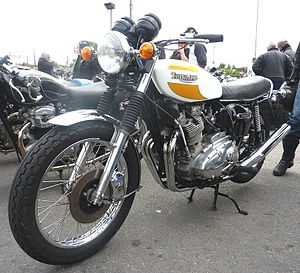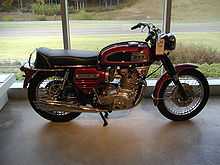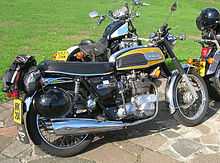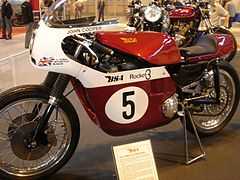BSA Rocket 3/Triumph Trident
 T160 Triumph Trident | |
| Manufacturer | BSA/Triumph |
|---|---|
| Parent company | Triumph Engineering |
| Production | 1968–1975 |
| Predecessor | none |
| Successor | none |
| Engine | air-cooled 740 cc OHV transverse triple |
| Power | 58 bhp (43 kW) @ 7,500 rpm |
| Transmission | chain |
| Brakes |
1968–1971: 2LS drum/drum 1972–1975: disc/drum 1975: disc/disk T160 |
| Weight |
468 lb (212 kg) (dry) |
| Fuel consumption | 30–40 mpg |
The BSA Rocket 3/Triumph Trident was the last major motorcycle developed by Triumph Engineering at Meriden, West Midlands. It was a 750 cc air-cooled unit construction pushrod triple with four gears and a conventional chassis and suspension. The motorcycle was badge-engineered to be sold under both the Triumph and BSA marques. The Rocket 3/Trident was part of Triumph's plan to extend the model range beyond their 650 cc parallel twins. Created to meet the demands of the US market, the smooth 750 cc three-cylinder engine had less vibration than the existing 360° twins. Although BSA experienced serious financial difficulties,[1] 27,480 Rocket 3/Tridents were produced during its seven-year history.
Development
Although designed during the mid-1960s, the BSA Rocket 3/Triumph Trident engine originated in a 1937 parallel twin: the 500 cc Triumph Speed Twin, designed by Edward Turner. The 1938 Tiger 100 was a sports version of the Speed Twin; the Trident three-cylinder engine is a larger version (although the triple has a longer stroke than the Tiger 100 engine). Following Triumph tradition, the OHV Trident engine has separate camshafts for the inlet and exhaust valves.[2]
The three-cylinder design was developed in 1962 by Bert Hopwood and Doug Hele. Test engineers developed the chassis' handling characteristics by affixing lead weights on a standard 650 Bonneville. The first prototype (P1) was running by 1965, and it seemed that Triumph might have a machine in production by 1967.

However, the decision to produce a BSA version with sloping cylinders and employ Ogle Design to give the early Tridents/Rocket 3s their "square tank" added bulk and 40 lb (18 kg) of weight, delaying production by 18 months.[3]
In 1966 a P2 prototype was produced with a more production-based Trident engine, different bore and stroke dimensions and improved cooling. Hele got 90 bhp (67 kW) from a Trident engine, leading to speculation that if development had quickened in 1964 a 140 mph (230 km/h) British superbike could have been produced by 1972.
Although most British motorcycles used a wet multiplate clutch, this triple had a dry single-plate clutch in a housing between the primary chaincase and the gearbox. Mounted on the end of the gearbox mainshaft (where the clutch would be expected) was a large transmission shock-absorber.
All the three-cylinder engines (and the Rocket 3 motorcycles) were produced at BSA's Small Heath site, but final assembly of the Triumph Trident model was carried out at Meriden in Coventry. The major differences were the engine and frame: the BSA had an A65-style double-loop cradle frame (with engine mounted at a slant), while the Triumph had a Bonneville-style single downtube frame with vertical cylinders. Other differences were cosmetic. Triumphs sold better in the US, despite BSA's Daytona racing successes during the early 1970s. Sales did not meet expectations; for the 1971 model year a fifth gear was added, creating the BSA A75RV and Triumph T150V. BSA were having financial difficulties, and only some 205 five-speed Rocket 3s were built before production of the BSA variant ceased. Production of the five-speed Triumph T150V (with a front disc brake replacing the original drum) continued until 1974. For the 1975 model year, the Trident was updated to the T160.
Reception

The prototype triples had the "Triumph look", with a teardrop-shaped tank. BSA/Triumph then commissioned Ogle Design for a redesign, leading to an 18-month delay. The new motorcycle had a squarer fuel tank and a less-traditional look, with sloped cylinders and "ray-gun" silencers.
The Rocket 3/Trident was introduced in summer of 1968 to critical acclaim,[4] but was eclipsed four weeks later by the Honda CB750. Compared to the British triple, the CB750 had a five-speed gearbox, overhead camshaft, oil-tight engine, electric start and disc brakes. The Honda outsold the Triumph in the US market; in 1970, to revive sales Triumph restyled export versions with the "classic" look.
In 1968 the new triples disappointed the American BSA-Triumph management, who knew that Honda had a motorcycle under development. They felt the price of $1,800 (£895)[5] was too high, and technical details (like vertically-split crankcases and a pushrod OHV valve train were too conventional. However, they acknowledged that the bike was fast and the US sales team launched it by setting speed records at Daytona (which were only broken in 1971 by the Kawasaki Z1).

Triumph X75 Hurricane

US BSA vice-president Don Brown felt that the BSA/Triumph triples needed a different look to succeed in the US. He commissioned designer Craig Vetter to redesign the BSA A75 (making it sleeker and better balanced) and disclosed the Vetter project to Peter Thornton (president of BSA/Triumph North America). In October 1969, Vetter displayed his customised A75. The bike was then sent to the UK, where it received a lukewarm reception from chief designer Bert Hopwood (but a favourable public reaction); the Vetter BSA Rocket3 became the Triumph X75 Hurricane.
Model T160
In November 1974, the T150V was succeeded by the modified T160. Some changes were due to market response to the earlier Tridents; others complied with American safety legislation. With forward-sloping cylinders (like the BSA Rocket3), electric start and a left-hand gearshift, NVT made a final effort to save large-scale production and reduce the gap between the Trident and the Honda CB750. The T160 was manufactured for a little over a year, with production ending in early 1976 (when NVT collapsed).[6] Around 7,000 T160 models were built for the 1975 model year; due to slow sales some were still being sold as late as the end of 1977.[7]
New features of the T160 were:
- Forward-leaning cylinder layout derived from BSA Rocket 3 (allowing a larger air box)
- Improved centre of gravity
- Electric start
- Five-speed gearbox
- Front and rear disc brakes
- Left-hand gear shift (US safety requirement)
- Annular silencers (to meet lower US noise-level requirement)
- Redesigned instrument panel and handlebar switchgear
- Return to traditional Triumph styling
Cardinal
In December 1975 final shipments of 288 and 224 motorcycles were destined for Australia and the US, respectively, but NVT diverted them to fill an order from the Saudi Arabian police force. Most UK police had switched to BMW motorcycles, but a few (such as the Yorkshire Constabulary) still used the Trident. About 450 bikes were sent to Saudi Arabia; the last 130 were still in the UK when the Saudis cancelled the remainder of the order, and NVT Motorcycles sold them as the Triumph Cardinal. At the time, the list price of a stock T160 was £1,215;[8] although the "police accessories" were worth only £150, NVT listed the Cardinal for £1,522.80. In 1982, European dealers imported about 180 low-mileage Tridents from Saudi Arabia; the poorly maintained, sand-encrusted machines were restored and sold as standard T160s.
Quadrant
The Triumph Quadrant was designed and built by Doug Hele in 1973.[9] It was a 1,000 cc four-cylinder motorcycle made from Trident parts (although the camshaft was sourced outside the factory). The fourth cylinder resulted from grafting an extra mid-crankcase unit; since the primary chaincase and final drive sprocket could not be moved, the fourth cylinder protruded from the right side of the bike.
Why Hele developed this machine is unknown, since the lopsided design could never compete with Japanese motorcycles such as the Honda CB750 or the Kawasaki Z1. An inside view is that Hele's efforts were a waste of resources that, with NVT's precarious finances, should have been directed to marketing the 900 cc triple Thunderbird III.[10]
Model T180 Thunderbird III
In 1975 an NVT prototype 900 cc triple, the T180 Triumph Thunderbird III, was developed but it did not reach production. NVT passed on the prototype to the Meriden co-operative, which also did not proceed to production (despite experimenting with the engine in an oil-bearing frame).[11]
Racing achievements

Doug Hele continued to develop the engine, and in 1971 joined frame expert Rob North to produce the Formula 750 racing machines. At the 1971 Daytona 200 the British three-cylinder bikes took the top three places; Dick Mann won on a BSA Rocket 3, followed by Gene Romero on a Triumph Trident and Don Emde third on another BSA Rocket 3.[12] John Cooper rode a BSA Rocket 3 to an upset victory over 500 cc world champion Giacomo Agostini in the 1971 Race of the Year at Mallory Park.[13] Cooper finished three-fifths of a second ahead of Agostini's MV Agusta.[14]
The best-known bike was Slippery Sam, a production-class Trident prepared by a team led by Les Williams. Slippery Sam won consecutive 750 cc production races at the Isle of Man TT for the five years between 1971 and 1975, and in the new F750 event for race-specification machines, Triumph and BSA machines with Rob North frames placed first and second.[15] Bert Hopwood recommended a production version of the racing triple, producing 84 bhp (63 kW) at 8,250 rpm, but his suggestion was not adopted. Further racing development was done in Duarte, California under racing manager Dan Macias.
Tom Mellor set four world speed records at the Bonneville Salt Flats in September 2008 with a 1969 Triumph Trident T150.[16]
End of production
Financial and management problems at BSA and the disintegration of the British motorcycle industry during the early 1970s led to a government-sponsored merger in July 1973 with Norton. However, the restructuring plans announced by the newly formed Norton-Villiers-Triumph (NVT) triggered a strike at Triumph's Meriden factory in mid-September. Production of the Trident was eventually transferred to BSA's Small Heath factory in March 1974, but the long disruption resulted in the production of few 1974 Tridents.[17][18]
See also
References
Notes
- ↑ Bacon, 1995. p.114.
- ↑ Bacon, 1995. p.108.
- ↑ Margie Siegal (September–October 2009). "1971 BSA Rocket 3". Motorcycle Classics. Retrieved 20 August 2009.
- ↑ Phillip Tooth (May–June 2010). "Triumph Trident 150". Motorcycle Classics. Retrieved 21 May 2010.
- ↑ Bacon, 1995. p.115
- ↑ Bacon, 1995. p.115-116.
- ↑ Roland Brown (January–February 2006). "Triumph T160 Trident". Motorcycle Classics. Retrieved 19 August 2009.
- ↑ Bacon, 1995. p.192.
- ↑ Motorcycle Classics article on George Poole's home-made Triumph Quadrent
- ↑ "BSA – Born 1861, Died 1973" Bill Murray July 1984
- ↑ Save The Triumph Bonneville ! The Inside Story of the Meriden Workers' Co-op by John Rosamond (Veloce 2009)
- ↑ "Icon: 1971 Daytona 200". motorcyclistonline.com. Retrieved 9 January 2013.
- ↑ "Mallory Park history". mallorypark.co.uk. Retrieved 11 June 2011.
- ↑ "John Cooper". motopaedia.com. Retrieved 11 June 2011.
- ↑ IoM TT official site, 1971 overview Retrieved 7 March 2015
- ↑ Alan Cathcart (July–August 2009). "Tom Mellor's Record Breaking Triumph Trident T150". Motorcycle Classics. Archived from the original on 24 June 2009. Retrieved 4 August 2009.
- ↑ "Meriden-a few ad hoc observations" Bill Murray 24 March 1983
- ↑ "BSA – Born 1861, Died 1973" Bill Murray July 1984
Bibliography
External links
| Wikimedia Commons has media related to Triumph motorcycles. |